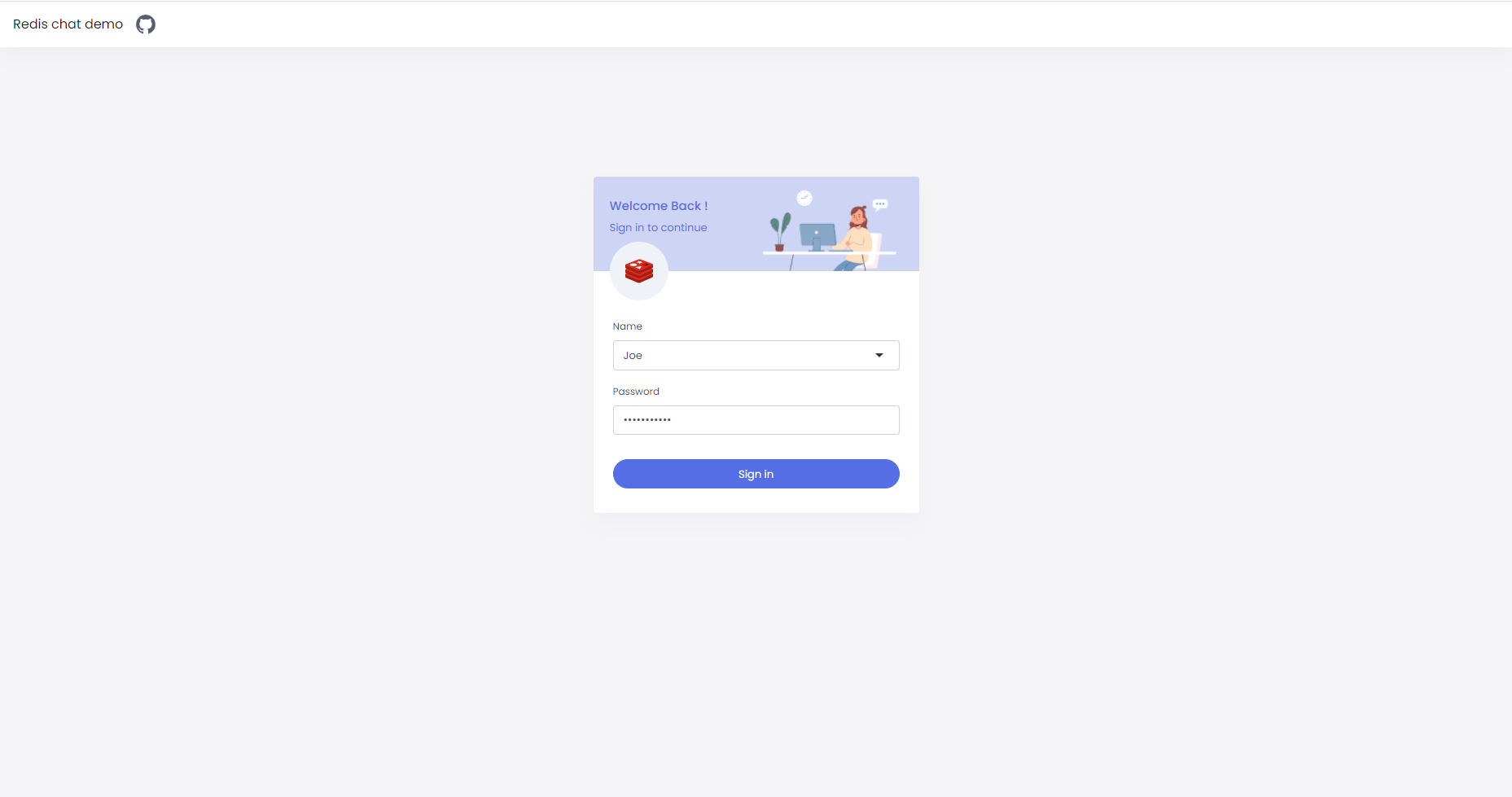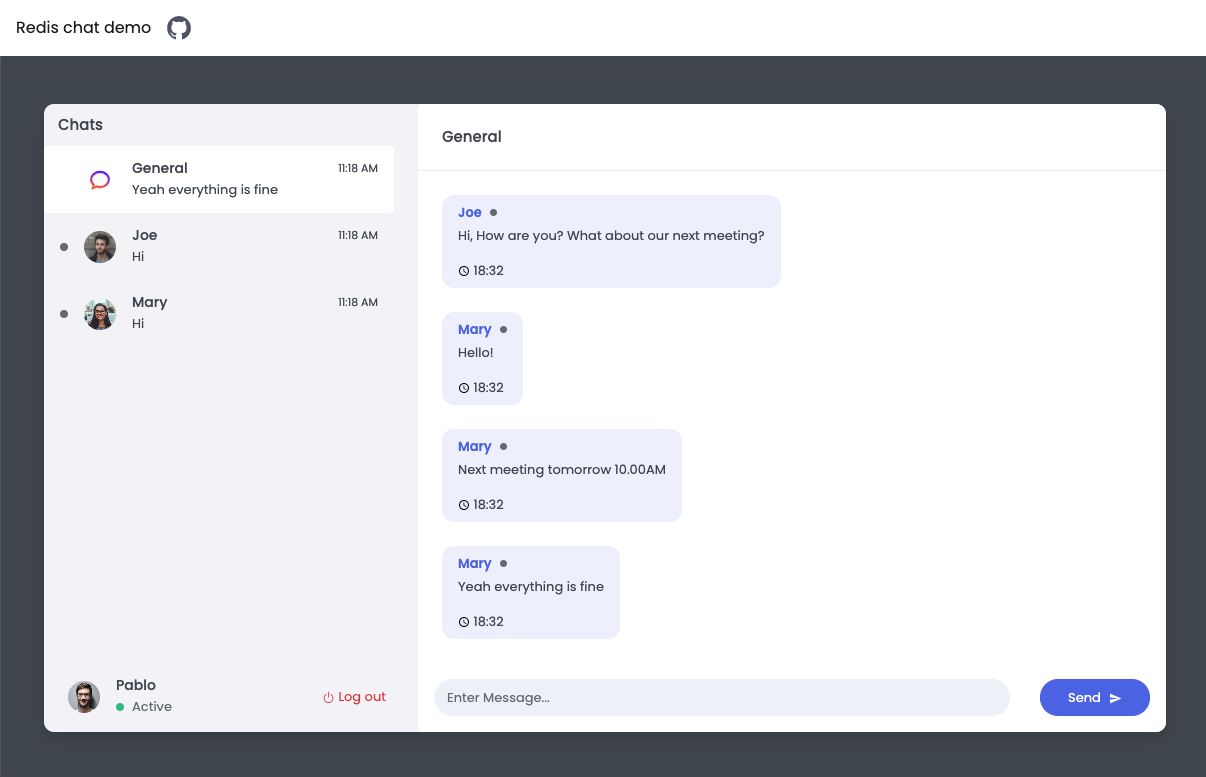Showcases how to implement chat app with ASP.NET Core, SignalR and Redis. This example uses the pub/sub feature combined with Websockets from SignalR for implementing the message communication between client and server.
Here's a short video that explains the project and how it uses Redis:
- Frontend - React, Socket (@microsoft/signalr)
- Backend - .Net Core 5.0, Redis (Microsoft.Extensions.Caching.StackExchangeRedis)
public class User : BaseEntity
{
public int Id { get; set; }
public string Username { get; set; }
public bool Online { get; set; } = false;
}public class ChatRoom : BaseEntity
{
public string Id { get; set; }
public IEnumerable<string> Names { get; set; }
}public class ChatRoomMessage : BaseEntity
{
public string From { get; set; }
public int Date { get; set; }
public string Message { get; set; }
public string RoomId { get; set; }
}For simplicity, a key with total_users value is checked: if it does not exist, we fill the Redis database with initial data.
EXISTS total_users (checks if the key exists)
The demo data initialization is handled in multiple steps:
Creating of demo users:
We create a new user id: INCR total_users. Then we set a user ID lookup key by user name: e.g. SET username:nick user:1. And finally, the rest of the data is written to the hash set: e.g. HSET user:1 username "nick" password "bcrypt_hashed_password".
Additionally, each user is added to the default "General" room. For handling rooms for each user, we have a set that holds the room ids. Here's an example command of how to add the room: e.g. SADD user:1:rooms "0".
Populate private messages between users.
At first, private rooms are created: if a private room needs to be established, for each user a room id: room:1:2 is generated, where numbers correspond to the user ids in ascending order.
E.g. Create a private room between 2 users: SADD user:1:rooms 1:2 and SADD user:2:rooms 1:2.
Then we add messages to this room by writing to a sorted set:
E.g. ZADD room:1:2 1615480369 "{'from': 1, 'date': 1615480369, 'message': 'Hello', 'roomId': '1:2'}".
We use a stringified JSON for keeping the message structure and simplify the implementation details for this demo-app.
Populate the "General" room with messages. Messages are added to the sorted set with id of the "General" room: room:0
Redis is used mainly as a database to keep the user/messages data and for sending messages between connected servers.
- The chat data is stored in various keys and various data types.
- User data is stored in a hash set where each user entry contains the next values:
username: unique user name;password: hashed password
- User data is stored in a hash set where each user entry contains the next values:
-
User hash set is accessed by key
user:{userId}. The data for it stored withHSET key field data. User id is calculated by incrementing thetotal_users.- E.g
INCR total_users
- E.g
-
Username is stored as a separate key (
username:{username}) which returns the userId for quicker access.- E.g
SET username:Alex 4
- E.g
-
Get User
HGETALL user:{id}- E.g
HGETALL user:2, where we get data for the user with id: 2.
- E.g
-
Online users: will return ids of users which are online
- E.g
SMEMBERS online_users
- E.g
var usernameKey = $"username:{username}";
// Yeah, bcrypt generally ins't used in .NET, this one is mainly added to be compatible with Node and Python demo servers.
var hashedPassword = BCrypt.Net.BCrypt.HashPassword(password);
var nextId = await redisDatabase.StringIncrementAsync("total_users");
var userKey = $"user:{nextId}";
await redisDatabase.StringSetAsync(usernameKey, userKey);
await redisDatabase.HashSetAsync(userKey, new HashEntry[] {
new HashEntry("username", username),
new HashEntry("password", hashedPassword)
});Each user has a set of rooms associated with them.
Rooms are sorted sets which contains messages where score is the timestamp for each message. Each room has a name associated with it.
-
Rooms which user belongs too are stored at
user:{userId}:roomsas a set of room ids.- E.g
SADD user:Alex:rooms 1
- E.g
-
Set room name:
SET room:{roomId}:name {name}- E.g
SET room:1:name General
- E.g
-
Get room name
GET room:{roomId}:name.- E. g
GET room:0:name. This should return "General"
- E. g
-
Get room ids of a user:
SMEMBERS user:{id}:rooms.- E. g
SMEMBERS user:2:rooms. This will return IDs of rooms for user with ID: 2
- E. g
//fetch all my rooms
var roomIds = await _database.SetMembersAsync($"user:{userId}:rooms");
var rooms = new List<ChatRoom>();
foreach (var roomIdRedisValue in roomIds)
{
var roomId = roomIdRedisValue.ToString();
//fetch all users in the rooms
var name = await _database.StringGetAsync($"room:{roomId}:name");
if (name.IsNullOrEmpty)
{
// It's a room without a name, likey the one with private messages
var roomExists = await _database.KeyExistsAsync($"room:{roomId}");
if (!roomExists)
{
continue;
}
var userIds = roomId.Split(':');
if (userIds.Length != 2)
{
throw new Exception("You don't have access to this room");
}
rooms.Add(new ChatRoom()
{
Id = roomId,
Names = new List<string>() {
(await _database.HashGetAsync($"user:{userIds[0]}", "username")).ToString(),
(await _database.HashGetAsync($"user:{userIds[1]}", "username")).ToString(),
}
});
}
else
{
rooms.Add(new ChatRoom()
{
Id = roomId,
Names = new List<string>() {
name.ToString()
}
});
}
}
return rooms;After initialization, a pub/sub subscription is created: SUBSCRIBE MESSAGES. At the same time, each server instance will run a listener on a message on this channel to receive real-time updates.
Again, for simplicity, each message is serialized to JSON, which we parse and then handle in the same manner, as WebSocket messages.
Pub/sub allows connecting multiple servers written in different platforms without taking into consideration the implementation detail of each server.
- Messages are stored at
room:{roomId}key in a sorted set (as mentioned above). They are added withZADD room:{roomId} {timestamp} {message}command. Message is serialized to an app-specific JSON string.- E.g
ZADD room:0 1617197047 { "From": "2", "Date": 1617197047, "Message": "Hello", "RoomId": "1:2" }
- E.g
- Get list of messages
ZREVRANGE room:{roomId} {offset_start} {offset_end}.- E.g
ZREVRANGE room:1:2 0 50will return 50 messages with 0 offsets for the private room between users with IDs 1 and 2.
- E.g
public async Task SendMessage(UserDto user, ChatRoomMessage message)
{
await _database.SetAddAsync("online_users", message.From);
var roomKey = $"room:{message.RoomId}";
await _database.SortedSetAddAsync(roomKey, JsonConvert.SerializeObject(message), (double)message.Date);
await PublishMessage("message", message);
}The chat server works as a basic REST API which involves keeping the session and handling the user state in the chat rooms (besides the WebSocket/real-time part).
When a WebSocket/real-time server is instantiated, which listens for the next events:
Connection. A new user is connected. At this point, a user ID is captured and saved to the session (which is cached in Redis). Note, that session caching is language/library-specific and it's used here purely for persistence and maintaining the state between server reloads.
A global set with online_users key is used for keeping the online state for each user. So on a new connection, a user ID is written to that set:
E.g. SADD online_users 1 (We add user with id 1 to the set online_users).
After that, a message is broadcasted to the clients to notify them that a new user is joined the chat.
Disconnect. It works similarly to the connection event, except we need to remove the user for online_users set and notify the clients: SREM online_users 1 (makes user with id 1 offline).
Message. A user sends a message, and it needs to be broadcasted to the other clients. The pub/sub allows us also to broadcast this message to all server instances which are connected to this Redis:
PUBLISH message "{'serverId': 4132, 'type':'message', 'data': {'from': 1, 'date': 1615480369, 'message': 'Hello', 'roomId': '1:2'}}"
Note we send additional data related to the type of the message and the server id. Server id is used to discard the messages by the server instance which sends them since it is connected to the same MESSAGES channel.
type field of the serialized JSON corresponds to the real-time method we use for real-time communication (connect/disconnect/message).
data is method-specific information. In the example above it's related to the new message.
The session data is stored in Redis by utilizing the StackExchange.Redis client.
services
.AddDataProtection()
.PersistKeysToStackExchangeRedis(redis, "DataProtectionKeys");
services.AddStackExchangeRedisCache(option =>
{
option.Configuration = redisConnectionUrl;
option.InstanceName = "RedisInstance";
});
services.AddSession(options =>
{
options.IdleTimeout = TimeSpan.FromMinutes(30);
options.Cookie.Name = "AppTest";
}); REDIS_ENDPOINT_URL = "Redis server URI:PORT_NUMBER"
REDIS_PASSWORD = "Password to the server"
From the BasicRedisChat Directory execute:
dotnet run



